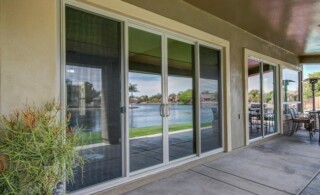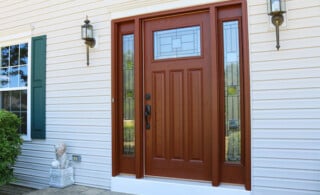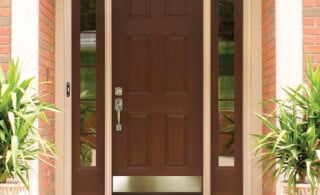
Photo: bmak / Adobe Stock
Fiberglass and steel are common options for household doors, and neither require extensive maintenance. Fiberglass is usually the more expensive choice, while being more energy-efficient. Steel is slightly more durable, but isn’t as customizable. This guide can help you determine which choice is best for you by laying out key differences between fiberglass and steel doors.
On This Page
- What’s the Difference Between Fiberglass and Steel?
- Fiberglass vs. Steel: Which Is Better?
- Which Is Best for Your Home?
- Fiberglass vs. Steel vs. Other Door Materials
| Fiberglass Doors | Steel Doors |
|---|---|
|
|
What’s the Difference Between Fiberglass and Steel?

Photo: bzzup / Adobe Stock
Fiberglass and steel are similar, but hold key differences that are important when deciding on your door’s material.
Fiberglass
Fiberglass is made from molten glass and various other resin materials.
Steel
Steel is created from melted down iron, which is a process called smelting.
Fiberglass vs. Steel: Which Is Better?

Photo: Photographee.eu / Adobe Stock
In order to determine which material is a better option for you, consider these important factors.
Appearance
Fiberglass doors are available in several styles, colors, and grains. They can also be painted or customized to your liking. If you have something particular or custom in mind, fiberglass is the better option.
Steel doors cannot be customized as much, as they come in fewer styles and typically cannot be painted to match your home.
Both steel and fiberglass doors can be finished with wood, but fiberglass is the material which will tend to look more like genuine wood.
Cost
The cost of steel and fiberglass doors depends on the style, size, and location. Steel is usually the more inexpensive option.
The cost to install an entryway door made of steel runs from $150 to $1,400, while installing a fiberglass door costs roughly $150 to $2,000.
Durability
Fiberglass, unlike wood, isn’t prone to moisture or humidity damage. It also resists various types of weather damage and rust.
Steel is also a strong material which can last you a long time.
Both materials are durable, but both, if not properly cared for, can get scratched or dented, but overall, steel will probably last a little longer than fiberglass.
Energy Efficiency
Fiberglass doors tend to be more energy-efficient than steel doors. This is because they usually are more durable in terms of general wear and tear and weather events.
Steel, like fiberglass, is a more energy-efficient option to wood. Steel can become hot when exposed to extremely high temperatures and/or direct sunlight, making it a little less energy-efficient than fiberglass.
Installation Ease
Installing a fiberglass door requires measuring the door frame, attaching hinges, and placing the door within the frame. Steel door installations involve having the material cut to fit into the doorway. You’ll need anchors and wall frames in order to do this.
Usually fiberglass doors are easier to install since the job doesn’t require cutting out the door. They are pre-hung and just need to be installed onto the hinges.
While installing interior doors can be doable DIY projects, installing exterior doors is usually a job that requires a professional. When installing an exterior door, it’s crucial that the door is weather-tight in order to prevent water damage and maintain your home’s security.
This is a more substantial project and usually requires hiring a door installation professional.
Maintenance
Neither steel doors or fiberglass doors require substantial maintenance, but like most furniture, there will be some upkeep tasks.
For fiberglass doors, you can wipe them down or spray them with a pressure washer. Make sure to keep the pressure washer on a low setting, as the higher settings can dent fiberglass.
Steel doors should be oiled, but not hosed down frequently, as this can lead to rust. You can periodically inspect the door and frame to see if there are necessary repairs or spots that need to be repainted.
Which Is Best for Your Home?

Photo: Photographee.eu / Adobe Stock
Both fiberglass and steel have a multitude of benefits. Both are durable, low-maintenance, and are available in various styles. The two biggest differences are cost and energy-efficiency.
Cost
If you’re looking at the cost factor, steel wins, as it almost always comes at a lower price.
Energy Efficiency
In terms of energy-efficiency, fiberglass is the winner. Fiberglass is able to withstand weather-related events more so than steel, and they are less likely to rust or deteriorate.
Fiberglass vs. Steel vs. Other Door Materials

Photo: U. J. Alexander / Adobe Stock
Fiberglass and steel aren’t the only materials on the table. To make the most informed decision, consider various options and their key characteristics.
Vs. Wood
Wood doors can bring a warm feel to your home. Wooden doors can also be carved to feature beautiful designs. One of the major limitations to wood doors is that they require maintenance. Wood doors, when exposed to the outdoors, can bubble, peel, and fade.
Wood doors are prone to moisture, which causes mold or mildew growth. When rainwater seeps into the material, the result is that air will exit. This makes wood doors less energy-efficient than other options.
Entryway wood doors tend to be more expensive than fiberglass and steel, costing around $500 to $3,000 on average.
Vs. Aluminum
Aluminum is common for window and patio doors. It is strong and durable and available in several finishes. Aluminum doors are also low maintenance.
Aluminum is prone to dents and scratches, which can break down the protective layer on the metal and result in corrosion.
Vs. Vinyl
Vinyl is not as environmentally-friendly as fiberglass or steel. It isn’t easily recyclable, often emits harmful chemicals during installation and can release harmful fumes if it melts.
One upside of vinyl doors is that since the material is somewhat flexible, it’s easier to install than more stiff materials such as fiberglass.
 Replacing Your Sliding Door Like a Pro
Replacing Your Sliding Door Like a Pro  Golden Glide: Sliding Closet Doors
Golden Glide: Sliding Closet Doors  Save Space with a Rectractable Screen Door
Save Space with a Rectractable Screen Door  Prehung Doors: Easy Entry or Ready-Made Jamb?
Prehung Doors: Easy Entry or Ready-Made Jamb?  The Benefits of Adding Kick Plates to Your Home
The Benefits of Adding Kick Plates to Your Home 

Are You Familiar With This Topic? Share Your Experience.